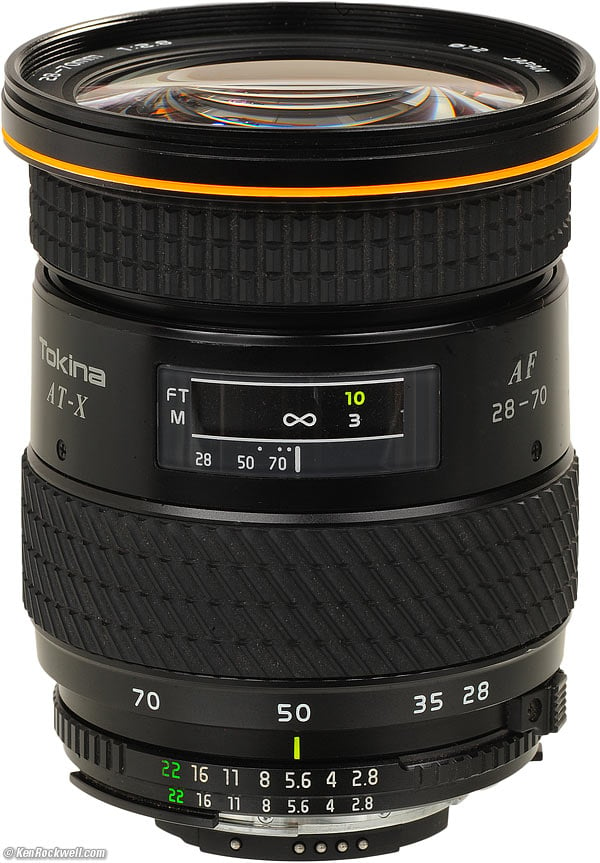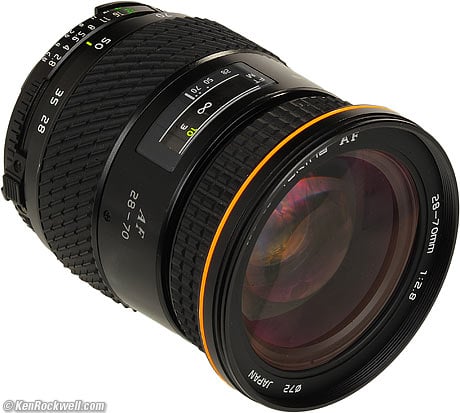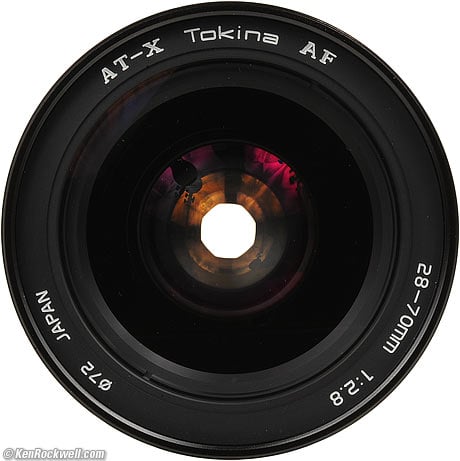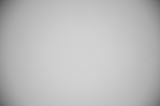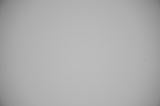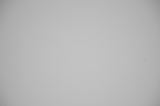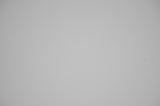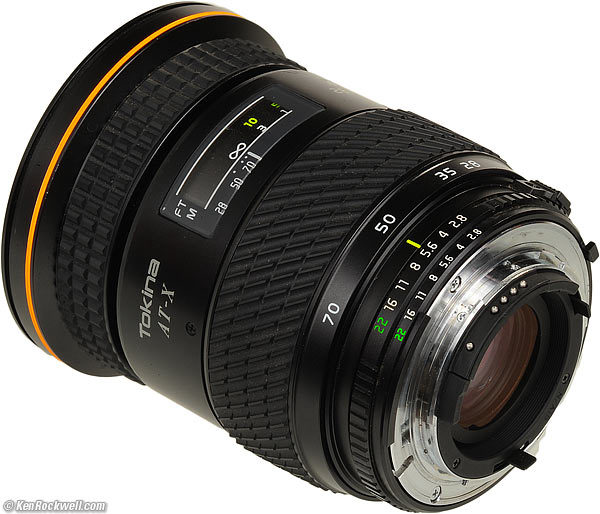Home Donate New Search Gallery Reviews How-To Books Links Workshops About Contact
Tokina 28-70mm f/2.8
FX, 35mm and DX; AT-X AF (c. 1990)
© 2011 KenRockwell.com. All rights reserved.
Intro Specs Performance Compared Recommendations
Tokina 28-70mm f/2.8 AT-X AF (72mm filters, 21.4 oz./608g, 2.3'/0.7m close focus, about $250 used). enlarge. This free website's biggest source of support is when you use any of these links, especially this direct link to this lens at eBay (see How to Win at eBay), when you get anything, regardless of the country in which you live. Thanks! Ken.
August 2011 More Tokina Reviews All reviews
Nikon Reviews Nikon Lenses Canon Reviews Canon Lenses
| Optics: | |
| Mechanics: | |
| Ergonomics: | |
| Usefulness: | |
| Availability: | |
| Overall: |
Ideal Uses
Perfect for use on FX digital and 35mm as a general-purpose fast medium zoom for everything.
Not for
It works, but I wouldn't lug around this big FX lens on a DX camera; I'd get a smaller DX lens instead. This won't autofocus with the cheapest Nikon D40, D40x, D60, D3000, D3100, D5000 or D5100.
Introduction top
Intro Specs Performance Compared Recommendations
|
|
This Tokina 28-70mm f/2.8 is a bargain of a fast medium zoom. It's all-metal and better built than anything from Nikon in this price range new.
It's optical performance isn't quite as good at f/2.8 as Nikon's $1,000 lenses, but this Tokina is super sharp most of the time, and it's smaller and lighter than any of Nikon's f/2.8 zooms. I'd rather carry this lens all day than the beastly Nikon 28-70mm f/2.8.
This Tokina 28-70mm f/2.8 has come in mounts for Nikon, Canon, Pentax, Sony, Minolta, and I forget what else.
I'm addressing the Nikon mount version here; you may make the usual extrapolations for other mounts.
This is a full-frame (FX) lens, and I will be testing it as such.
This lens, in Nikon mount, works especially well with on FX, 35mm and DX Nikons like the D7000, D700, D3X, D300s and F6. It works fantastically on manual-focus cameras like the F2AS, F3, FE and FA, since it has real manual-focus and aperture rings that work exactly as they should.
The Nikon version 28-70mm f/2.8 AF works great with almost every film and digital Nikon camera made since 1977. You'll need to figure out a way to add a meter coupling prong for use with Nikons made from 1959-1976, if you want meter coupling that far back.
The only incompatibility is that it will not autofocus with the cheapest Nikon D40, D40x, D60, D3000, D3100, D5000 or D5100, but if you focus manually, everything else works great. These cameras have in-finder focus confirmation dots to help you.
See Nikon Lens Compatibility for details on your camera. Read down the "AF, AF-D (screw)" column for this lens.
Warning: as a non-Nikon lens, there is never any guarantee that this Tokina lens will always work perfectly with every possible camera. I've only used it on the D3 and D7000. There is always the potential for it not to work on some models of camera, today or newer models in the future. This is the one chance you take with non-Nikon lenses.
Tokina AT-X 28-70mm f/2.8 AF. enlarge.
Specifications top
Intro Specs Performance Compared Recommendations
Tokina calls this the Tokina AT-X 28-70mm F2.8 AF.
AT-X: Advanced Technology-seX.
AF: Autofocus.
Conventional spherical elements.
Front-group focusing.
Front and rear groups move as zoomed.
Multicoated, but not as efficient as camera-maker-brand lenses.
Tokina 28-70mm f/2.8 at 50mm and f/5.6. enlarge.
8 straight blades.
Stops down to f/22 at infinity.
Engraved metal aperture ring with full-stop clicks.
Coverage top
Focal Length top
28-70mm.
When used on a DX camera, it gives angles of view similar to what a 42-105mm lens gives when used on an FX or 35mm camera.
2.3 feet (0.7 meters).
Hard Infinity Focus Stop? specs top
YES!
Just set it at the stop for astronomical shots.
Yes.
Depth-of-Field Scale specs top
No.
Infra-Red Focus Indices specs top
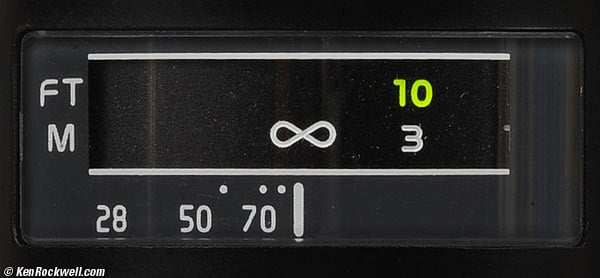
Tokina 28-70mm f/2.8 AT-X Focus Scale.
Yes, dots at 28mm, 50mm and 70mm.
Yes, engraved metal.
Full-stop clicks.
72mm, metal.
Rotates with focus and moves in and out as zoomed.
3.6" (91mm) extension from flange by 2.9" (74mm) diameter, Nikon mount, measured at smallest size (zoom at 65mm and focus at infinity).
21.430 oz. (607.5g), measured.
Plastic bayonet.
Made in Japan.
Performance top
Intro Specs Performance Compared Recommendations
Overall Auto and Manual Focus Bokeh Coma Distortion
Ergonomics Eyeblow Falloff Filters Flare and Ghosts
Focus Breathing Color Fringes Macro Mechanics
Sharpness Spherochromatism Sunstars Survivability
Overall performance top
The Tokina AT-X 28-70mm f/2.8 AF is the smallest and lightest f/2.8 zoom I've ever seen. It's optics are softer than camera-brand zooms at f/2.8, but its mechanics are first rate. I'd depend on this lens to last me 30 more years over most lenses from Nikon today.
Auto and Manual Focus performance top
AF Speed
Autofocus is fast for normal uses.
One full turn (two half-turns) of the AF screw pulls focus from infinity down to 7 feet.
AF Accuracy
AF is always right-on on my D7000 and D3.
Manual Focus
Manual focus is beautiful! It's smooth and light, working without needing any lube or damping.
It's smooth and perfectly geared for the best possible combination of speed and precision.
Bokeh performance top
Bokeh is pretty good.
Bokeh is the character of out of focus areas, not simply how far out of focus they are.
Coma performance top
Coma, weird smeared blobs that appear around bright points of light in the corners, is present at the largest apertures and wider zoom settings. See also sagittal coma flare.
Distortion performance top
The Tokina AT-X 28-70mm f/2.8 AF has the usual distortion expected in a fast zoom: barrel at wide, and pincushion at tele. The Nikon 28-70mm f/2.8 AF-S has the same distortion at 28mm, and less at 70mm.
Plugging the figures into Photoshop's lens distortion filter to correct it. These aren't facts or specifications, they are the results of my research that requires hours of photography and calculations on the resulting data.
FX and Film at 3 meters (10') |
FX and Film |
||
28mm |
+3.0* |
tbd |
tbd |
35mm |
+0.5 |
tbd |
tbd |
50mm |
-2.5 |
tbd |
tbd |
70mm |
-3.0 |
tbd |
tbd |
© 2011 KenRockwell.com. All rights reserved.
* Some waviness remains after correction.
Ergonomics performance top
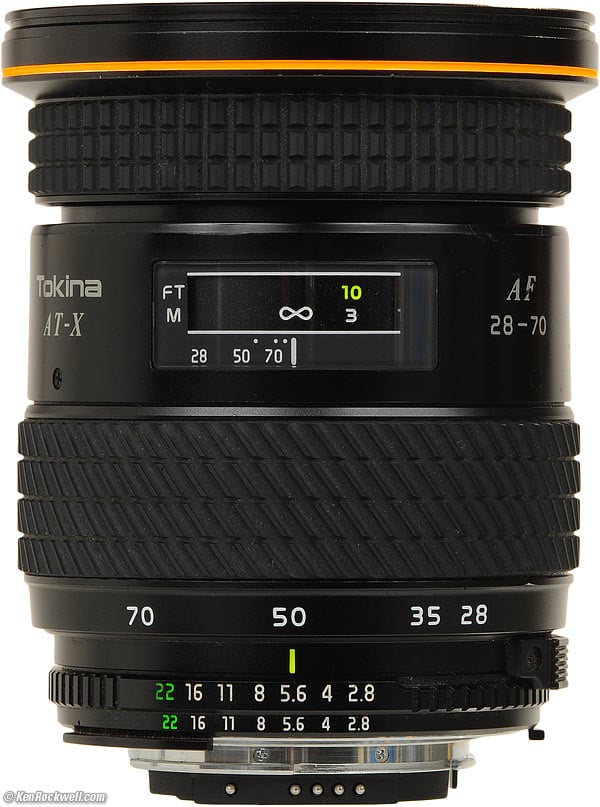
Tokina AT-X 28-70mm f/2.8 AF.
Ergonomics are easy. Except that you still need to move a switch on your Nikon to swap between auto and manual focus, everything just feels right.
The all-metal construction and smooth manual focus really make this lens feel nice to use. My biggest whine is that the zoom range is congested at the 28mm end.
Eyeblow performance top
As the 28-70mm f/2.8 AF-S is zoomed in and out, very little air pumps in and out of the rear of the lens, and I can't detect any air blowing out of my eyepiece.
Falloff (darkened corners) performance top
Falloff on FX is minimal. It's invisible except at 28mm and f/2.8.
It will be even less of an issue on DX (see crop factor).
I've exaggerated this by shooting a gray field and placing these on a gray background:
Tokina AT-X 28-70mm f/2.8 AF falloff on FX and film, no correction.
© 2011 KenRockwell.com. All rights reserved.
|
Filters, Use with performance top
The solid metal filter ring rotates with focus and moves in and out as zoomed.
There is no problem with vignetting, even at 28mm on FX. If you're going to have vignetting, it will be at 28mm.
Flare and Ghosts performance top
There is more flare and potential for ghosting than other lenses if pointed into the sun.
I wouldn't worry about using a hood, but do remember to shield the sun with your hand if it's glaring into the lens.
Focus Breathing performance top
Of interest mostly to cinematographers focusing back and forth between two subjects, the image from the Tokina 28-70 2.8 gets slightly smaller as focused more closely.
Lateral Color Fringes performance top
There are some lateral color fringes on the D3 or the D7000, which can't always correct them.
It's blue-yellow at 28mm, and gone from 35mm through 70mm.
Macro performance top
There's no separate macro mode; you can focus to 2.3 feet (0.7 meters) at every focal length.
Mechanics performance top
Rear, Tokina 28-70mm f/2.8. enlarge.
This Tokina is a surprisingly well-made lens. It's not made in China out of plastic like most of Nikon's lenses today.
Filter Threads
Metal.
Hood
Plastic bayonet.
Hood Bayonet Mount
Metal.
Fore Barrel
Metal.
Focus Ring
Metal; rubber covered.
Distance markings are engraved into the metal and seen behind a clear plastic window.
Mid-barrel Exterior
Plastic.
Zoom Ring
Metal; rubber covered.
Aft Barrel Exterior
Plastic.
Internals
Seem like metal.
Aperture Ring
Metal with engraved and filled numbers.
Mount
Metal. Mounts almost as well as Nikon's mounts.
Markings
Paint.
Identity
Engraved on front ring, and painted on midbarrel.
Serial Number
Engraved and filled with paint on bottom of aperture ring.
Rain seal at mount
No.
Noises When Shaken
Mild clicking and klunking.
Made in
Japan.
Sharpness performance top
Warning 1: Image sharpness depends more on you than your lens.
Warning 2: Lens sharpness doesn't mean much to good photographers.
At 28mm
It's completely sharp, even on an 16 MP DX Nikon D7000, at f/2.8 in the center.
The corners of FX are blurry at f/2.8, much better at f/4, and optimum by f/8.
At 35mm
It's completely sharp, even on an 16 MP DX Nikon D7000, at f/2.8 in the center.
The corners of FX are a little blurry at f/2.8, much better at f/4, and optimum by f/8.
At 50mm
It has a little "Tokina glow" (spherical-aberration induced softness or haziness) at f/2.8 in the center of a 16 MP DX Nikon D7000. It's completely clear by f/4.
The corners of FX are a little blurry at f/2.8, much better at f/4, and optimum by f/8.
At 70mm
It has a plenty of "Tokina glow" (spherical-aberration induced softness or haziness) at f/2.8 in the center of a 16 MP DX Nikon D7000. It's completely clear by f/4 or f/5.6.
The corners of FX are a little softer at f/2.8, and optimum by f/8.
Spherochromatism performance top
I can't see any spherochromatism. Whatever may or may not be here is hidden in the spherical aberration at long zoom settings and wide apertures.
Sunstars performance top
With its straight 8-bladed diaphragm, this Tokina 28-70 2.8 should make 8-pointed sunstars on bright points of light.
To get a 9-bladed diaphragm in a Tokina midrange zoom, look for the 28-80mm f/2.8 ATX-AF PRO.
Survivability performance top
The Tokina 28-70mm f/2.8 seems pretty solid, so long as you don't bash the front of the lens into something and break the zoom system.
Otherwise, it seems destined to last a lifetime. There's no plastic, as there is on even today's $1,800 Nikon 24-70mm f/2.8 AF-S.
Compared top
Intro Specs Performance Compared Recommendations
Compared to Nikon's professional midrange zooms, this Tokina is much softer at f/2.8 in the corners at 28mm and all over at 70mm, but this Tokina weighs and costs much less.
Distortion is about the same as Nikon's pro zooms.
This Tokina's focus ring turns far more fast and smoothly than any of Nikon's zooms.
Compared to the newer Tokina f/2.8 midrange zooms, this is the smallest and lightest. The newer lenses are bigger, heavier and tougher, however their optics are no better. In fact, the f/2.6-2.8 lens appears to have exactly the same optics, simply put into a different barrel and renamed to "f/2.6-2.8" by the sales department.
Tokina 28-70/2.6-2.8 |
Tokina 28-80/2.8 |
||
| Filter | 72mm |
77mm |
77mm |
| Filter Ring | Metal, rotates |
fixed |
fixed |
| Zoom | Front moves in and out |
Moves inside barrel |
Moves inside barrel |
| Optical quality | "Tokina Glow" at 70mm |
same optics as Tokina 28-70/2.8 |
"Tokina Glow" at 80mm |
| Diaphragm blades | 8 |
8 |
9 |
| Close focus | 2.3'/0.7m |
2.3'/0.7m |
2.3'/0.7m |
| Focus switch | On camera |
"PRO" Push-pull clutch |
"PRO" Push-pull clutch |
| Have to index focus ring to get back to AF? | No |
Yes |
|
| Weight | 21.4 oz./608g |
||
| Price |
Recommendations top
Intro Specs Performance Compared Recommendations
This Tokina AT-X 28-70mm f/2.8 AF is an inexpensive, well-built, light weight and fast midrange zoom. If you don't mind slightly less contrast at f/2.8 in the corners or at 70mm, you can save a whole lot of money and weight over the equivalent Nikon zoom, and this lens feels so good in-hand.
In fact, this f/2.8 Tokina is about the same size and weight as many of Nikon's slower zooms, and stopped down to the same apertures, as good as the other zooms. The extra stop of speed is essentially free, and always there for you if you need it, even if it's not quite as good as Nikon's f/2.8 lenses at f/2.8.
More Information
Both of these links go to casual amateur attempts to define what version does what; they are probably loaded with errors, but are points to consider if you're trying to make sense of the chromology.
I have three versions of this lens, this 28-70/2.8, the 28-70/2.6-2.8 and the 28-80/2.8, and all perform about the same optically, which is much worse than the Nikon 28-70/2.8 at f/2.8, especially in the corners and at the long end.
None of these Tokinas is sought after by anyone; they are inferior to Nikon, but much less expensive, too. I've never been a fan of the optics of the Canon 24-70/2.8, however, so especially consider these Tokina for Canon.
One layman's summary of the different versions.
Another laymans's summary of different versions.
Help me help you top
I support my growing family through this website, as crazy as it might seem.
The biggest help is when you use any of these links to Adorama, Amazon, eBay, B&H, Ritz, Calumet, J&R and ScanCafe when you get anything, regardless of the country in which you live. It costs you nothing, and is this site's, and thus my family's, biggest source of support. These places have the best prices and service, which is why I've used them since before this website existed. I recommend them all personally.
If you find this page as helpful as a book you might have had to buy or a workshop you may have had to take, feel free to help me continue helping everyone.
If you've gotten your gear through one of my links or helped otherwise, you're family. It's great people like you who allow me to keep adding to this site full-time. Thanks!
If you haven't helped yet, please do, and consider helping me with a gift of $5.00.
As this page is copyrighted and formally registered, it is unlawful to make copies, especially in the form of printouts for personal use. If you wish to make a printout for personal use, you are granted one-time permission only if you PayPal me $5.00 per printout or part thereof. Thank you!
Thanks for reading!
Mr. & Mrs. Ken Rockwell, Ryan and Katie.
Home Donate New Search Gallery Reviews How-To Books Links Workshops About Contact
